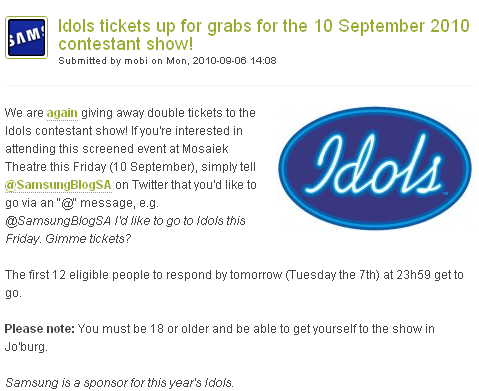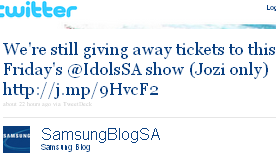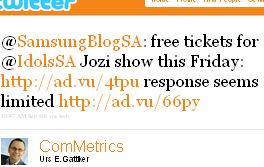Almost three weeks ago we launched our ComMetrics blog checklist from CyTRAP Labs GmbH. You can find a list of all preceding posts in our first one:
You can also still look forward to
- 10. 5 corporate blogging trends for 2011 (2010-11-03)
Yesterday, on HowTo.ComMetrics.com, we published
Today’s post addresses the social media DOs and DON’Ts for companies that want to keep up with their engaged community. In Forget inbound marketing, engagement is key, we suggested that people focus on the following four factors to increase engagement:
- 1. Separate private and business content,
2. Amplifying the message to your target-audience is key,
3. Social media is a consumer platform, and
4. Be prolific and leverage your user base to increase engagement.
In the fifth post of this series, Corporate blog definition: 4 essentials, we offered a further two pointers with examples regarding engagement:
- 5. Your blog is not a megaphone – enable and respond to commenting, and
6. Engagement is a long-term effort that takes time and patience.
Today we want to address the seventh and eighth points to consider when trying to improve engagement or customer relationship management while using social media.
- 7. Broadening your appeal in a digital multichannel world is difficult
The British tv show Hollyoaks was one of the early adopters of cross-channel marketing (see Sunday) to increase its appeal for fans. The hope was, of course, that using various social media channels would bring in additional revenue.
Other brands, such as Samsung South Africa, have also tried to go cross-channel in order to better connect with fans or clients.

 For instance, the Samsung blog had a post about the possibility of getting free tickets for an episode of a TV program the company sponsors.
For instance, the Samsung blog had a post about the possibility of getting free tickets for an episode of a TV program the company sponsors.
As outlined above, users had to send out a tweet to their Twitter followers to be eligible to win one of these tickets, such as a reply like this:
- @SamsungBlogSA love a ticket for going to @IdolsSA thanks
 A reply would make that person eligible to compete for the free tickets Samsung wanted to give away to its customers.
A reply would make that person eligible to compete for the free tickets Samsung wanted to give away to its customers.
I thought because of the popularity of the TV show, there would be thousands of tweets asking for free tickets. But I only found a few.
Some things seem obvious but warrant repeating, namely
 a) a corporate blog reader is not necessarily a Twitter user,
a) a corporate blog reader is not necessarily a Twitter user,b) Twitter users might not be interested attending the taping of a TV show, and
c) Idol fans may not read the Samsung South Africa blog (even though it is interesting if you have a Samsung mobile) OR use Twitter; they might only hang out on Facebook or Second Life.
Insight: This illustrates that one must ensure that the social media channels used actually reach the target audience BEFORE launching a free giveaway.
- 8. Blockheads use blockhead metrics
By the same token, I recently came across a guest blog post by Laura Hall which stated that P&G’s Future Friendly initiative should be taken as an example of:
- “…[Corporate social responsibility (CSR)] strategies that have undoubtedly amplified the good actions of [P&G] all while generating droves of supporters. From raising awareness, to connecting with consumers in the way they want to engage and fostering positive action, leveraging CSR in the social media world can strengthen consumer trust and loyalty, encourage followers (and their friends) to take action and participate, and put a halo over the brand that dives in.”
At first glance, some social media pundits might agree with Laura Hall that P&G’s Future Friendly generated strong ROE (Return On Engagement) over just a few months:
- – more than 20,000 followers took up the challenge on Facebook and committed to saving energy, water or reducing waste for 90 days, and
– in July, the Facebook page had about 48,000 followers/fans; in late October it has about 46,000 and 406 Twitter followers.
P&G’s objective was and remains unclear. The full marketing launch included TV advertising, agency fees and work hours by staff. Not to mention the travel time and expenses incurred by staff attending meetings such as the Clinton Global Initiative to tout the merits of The Future Friendly Challenge. In fact, the initiative may be an expensive fiasco.
Insight: For a particular use of social media to be truly effective, it must achieve its stated purpose. This requires spelling out what should be accomplished before launching a cross-channel initiative.
If your proof of engagement is nothing more than pageviews or Facebook fans, then Houston, we have a problem. A serious one.
Watch the video here:

Resources we previously published about blogging smarter to foster engagement:
- 1) Lessons 1 – 4: Starting your blogging off on the right foot
2) Lessons 5 – 7: Setting the stage – ready – go
3) Lessons 8 – 11: Whatever domain, home you choose – beware
4) Lessons 12 – 13: Getting the basic SEO issues right
5) Lessons 14 – 17: Authenticity and quality are key
6) Lessons 18 – 20: Improving blogging effectiveness
What is your take, what engagement strategies work for you? Please share your thoughts with a comment below!
- Article source: 8 guidelines for fostering social media engagement
Pingback: Social media definition: 3 essentials - social media monitoring, social media marketing, benchmark testing, Twitter monitoring, Facebook strategy, customer engagement - CyTRAP Labs provides customised social media monitoring, social media marketing servic
Pingback: Social media marketing definition: 2 essentials - social media monitoring, social media marketing, Twitter monitoring, Facebook strategy, customer engagement, customer relationship management, - CyTRAP Labs provides customised social media monitoring, soc
Pingback: Why PR fails with social media marketing » social media monitoring, social media marketing, Twitter monitoring, Facebook strategy, customer engagement, customer relationship management, » ComMetrics University social media seminar (Weiterbildung marketi
Pingback: 5 critical steps for reputation management » best practice, checklist, social media monitoring, social media marketing, benchmark testing, Twitter monitoring, Facebook strategy, customer engagement, reputation management » HowTo.ComMetrics
Pingback: 4 strategies to leverage usability tests » best practice, checklist, social media monitoring, social media marketing, benchmark testing, Twitter monitoring, Facebook strategy, customer engagement » ComMetrics University social media seminar (Weiterbildu
Pingback: CyTRAP
Pingback: Urs E. Gattiker
Pingback: Philzz
Pingback: Hana Guenzl
Pingback: Urs E. Gattiker
Pingback: CyTRAP
Pingback: Wildberry Enterprise
Pingback: Lori Taylor
Pingback: breizh2008
Pingback: CyTRAP
Pingback: Urs E. Gattiker
Pingback: Alex Hall
Pingback: Chunghyo Bak. 1979
Pingback: Green Lion Digital